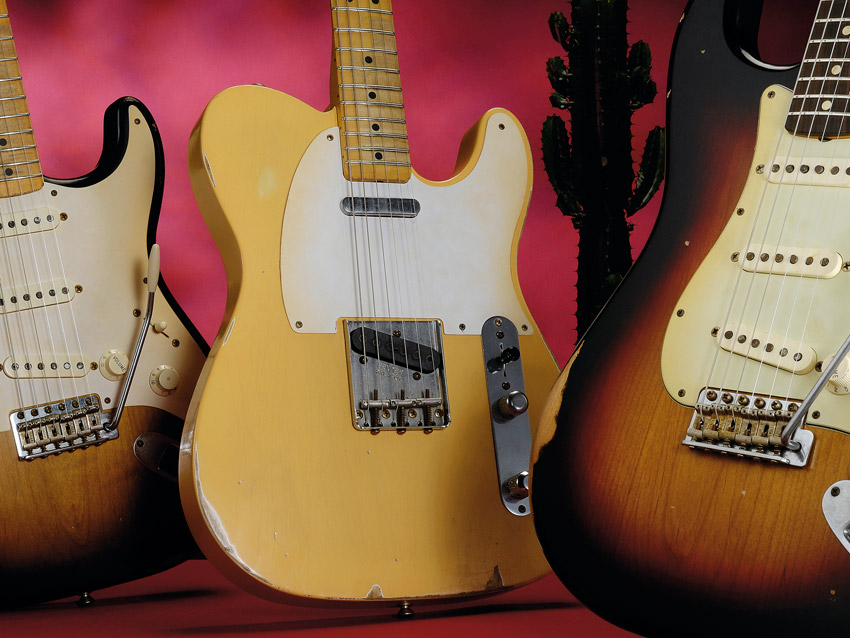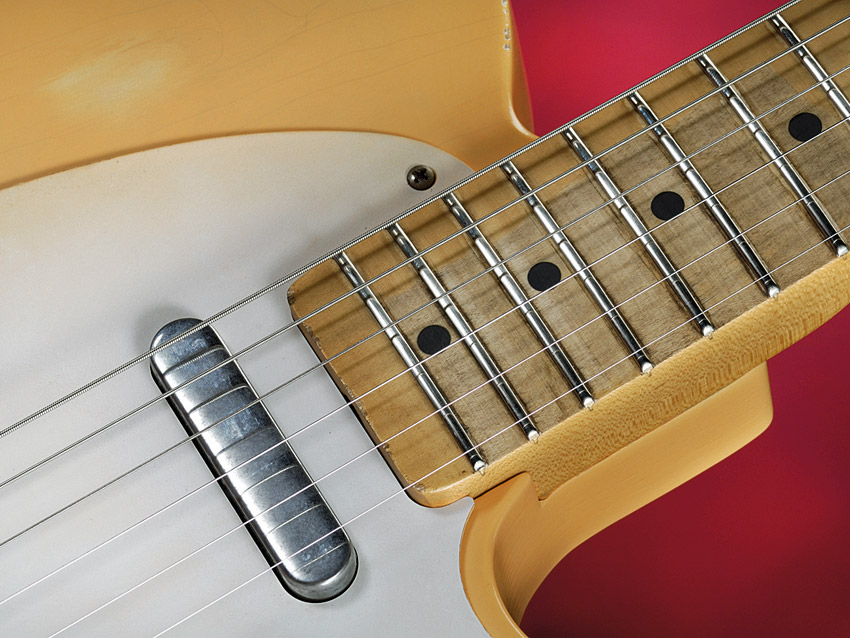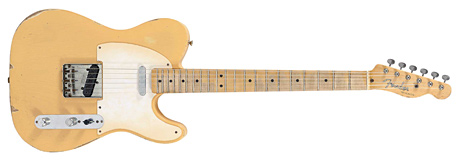MusicRadar Verdict
Captures the essence of an old guitar in looks and feel with a modern, yet classic, range of sounds.
Pros
- +
Accurate old look, feel and vibe. Big biting bridge pickup and thicker neck voice. Improved playability.
Cons
- -
It's weighty and colours are limited.
MusicRadar's got your back

Fender Road Worn '50s Telecaster

Fender Road Worn '50s Telecaster
This writer has yet to file a two-word guitar review but in this case it got close. What two words? Buy this! It really is that simple. Vintage Fender Strats, Teles, Precision or Jazz Basses, have to be among the most lusted after instruments for any guitar player.
Yet escalating prices, not to mention the question of authenticity, have put many of us off. Fender's so-called Time Machine Series brought the illusion of a vintage Fender to many more people: a high quality guitar, as close to the real thing as you could get, without the worry about authenticity or insurance.
You could keep your real one in a bank vault and gig the NOS, Closet Classic or Relic and only you would know. The trouble with that, however, is that for many of us £2k plus is still a lot of cash.
"Even before we plug in there's evidence that these guitars are about more than just looks - the acoustic ring is superb."
We got an inkling, however, that Fender was gearing up to do something about this dilemma when it launched the Joe Strummer Telecaster - the first, more affordable Mexican-made guitar that was aged and distressed.
We heard more rumours that the Mexican workforce were taking all sorts of implements to their usually finely finished guitars. At the end of 2008 we were let in on the secret: Fender had been working on a mini-range of 'Road Worn' guitars, Mexican Relics to you or us. The wait is over.
'50s Road Worn Telecaster

With its single-ply white scratchplate and unthreaded steel saddles this ash-bodied Tele is modelled more on a mid-fifties example rather than the early fifties Nocaster that's been the mainstay of Fender's Time Machine series for many years.
It also uses the post-1967 wiring that offers each pickup individually or, in the centre position on the three-way switch, combines both in parallel: 'normal' to most of us.
It's not the lightest Tele we've ever encountered but it's far from back breaking; the neck is quite full but not over big and those mirror-like bigger Dunlop 6105 frets make it play smoothly and precisely even though the fingerboard radius is an old-school 7.25-inches.
But it's the ageing that really seems to have moved on from Mexico's first 'relic', the Joe Strummer Tele. The thin blonde finish is muted and gloss-less and sinks into the ash's broad grain.
A cream undercoat is visible, and while there are numerous dings and scratches they all are sensibly placed. There's no belt-buckle wear but with the nitro-cellulose finish additional dings will swiftly appear after a few gigs - if you want a heavier relic there's always the DIY route!
But seriously, less is more. It looks, certainly from a few paces, very real indeed, perhaps with the exception of the more formularised fretboard 'wear'. The early fifties-style logo, the aged hardware and the slight colouration of the white single-ply guard really do look old. Only the Made In Mexico and serial number decals on the back of the head really give it away.
As with the rest of the range, Fender is using its well-accepted Tex-Mex pickups, although these ones look correctly old and used. But even before we plug in there's evidence that these guitars are about more than just looks - the acoustic ring of the guitar is superb. In our book, that's always a great place to start.
Sounds
If the look and feel of these guitars is old and worn, the sound is a little less specific, which might have vintage guitar forums buzzing but for the majority of players the pickup choice and the overall sounds are eminently useable.
The Tele is muscular sounding, blending its trademark stringy and steely bridge pickup with a thick, very useable neck pickup and that timeless dual-pickup voice that's such a great rhythm tone.
It might not be 100 per cent historically accurate but it's definitely the most useable switching configuration and, combined with a great volume control taper that enables easy swells and a tone that tames down the highs if you need before becoming a little too woolly, it's dead simple and so direct to use.
"That timeless dual-pickup voice is such a great rhythm tone."
There are plenty of microphonics, no hum-cancelling and a very vintage-y dry and woody resonance, which all combine to make the aged illusion more than skin deep.
To be honest, we're in a quandary. These are such good guitars, that really do capture such a vintage feel and tone, that your main dilemma is going to be deciding which Road Worn instrument to buy!
That 'which-to-buy' quandary is, of course, balanced by the price: you could buy the '50s and '60s Strats and the '50s Telecaster of these for the price of one Custom Shop Relic. And while the latter, depending on model, might be more vintage-accurate with more subtle ageing, higher spec wood and hardware and USA-made pickups, to be honest Fender might really have shot itself in the foot here.
Not all of us can justify the necessary £2k plus on a Relic, however much we want one, but aside from the most professional of situations we feel these Road Worns are going to be the answer for most of us mortals struggling through the credit crunch.
And don't forget, Teles and Strats are the easiest guitars in the world to mod: you could easily swap hardware or pickups if you want to be more vintage specific or if you feel those Costalot 'boutique' pickups are really worth it.
But our advice would be to live with what you have here, at least for a while. Yes, we've played Teles that are lighter/ heavier, have bigger/slimmer necks, are darker/brighter and so on but Fender has achieved a very balanced tonality here that few players should object to. In short, these are genuinely very, very good guitars.
Dave Burrluck is one of the world’s most experienced guitar journalists, who started writing back in the '80s for International Musician and Recording World, co-founded The Guitar Magazine and has been the Gear Reviews Editor of Guitarist magazine for the past two decades. Along the way, Dave has been the sole author of The PRS Guitar Book and The Player's Guide to Guitar Maintenance as well as contributing to numerous other books on the electric guitar. Dave is an active gigging and recording musician and still finds time to make, repair and mod guitars, not least for Guitarist’s The Mod Squad.
With its latest free update, Ableton has finally turned Note into the app I always wanted it to be
Technically capable, but struggle to make your tunes sound musical? 5 simple music theory hacks to make your tracks stand out
"Despite its size, it delivers impressive audio quality and premium functions as well as featuring a good selection of inspired sounds": Roland GO:Piano 88PX review










